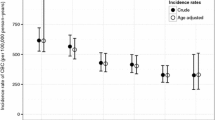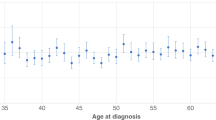Abstract
Women who have been treated for breast cancer are typically followed up with regular mammography and palpation, with the aim of detecting recurrences and contralateral breast cancer (CBC). This study aims to investigate if the diagnostic work-up of breast cancer patients has improved over the last 25 years and resulted in earlier diagnoses of CBC. Two population-based cohorts were used; all CBCs in Sweden 1976–2004 (n: 2932), and all CBCs in Stockholm, Sweden, 1976–2005 (n: 626), both cohorts with a maximum of 3 years between the two cancers. Synchronous CBC was defined as two cancers <3 months apart, the remainder was defined as metachronous CBC. We calculated the odds ratio of being diagnosed synchronously, relative to metachronously, using logistic regression, adjusting for whether the second cancer was detected through clinical work-up or not. The odds of synchronous CBC were significantly increased: 1.27 (95% CI, 1.13–1.42) per 5-year period, compared to metachronous, and was not affected by detection mode, but seemed to be explained by adjuvant therapy. The proportion of CBCs detected by clinical work-up did not increase over the study period, and the mean size of the second tumor remained constant. We found an increase in the proportion of synchronous CBCs compared to metachronous, over calendar period, a change that was not associated with clinical work-up, but with adjuvant therapy. This study gives no indications that any improvement in diagnostic work-up of CBC have occurred over the last 25 years.


Similar content being viewed by others
References
Hungness ES, Safa M, Shaughnessy EA, Aron BS, Gazder PA, Hawkins HH, Lower EE, Seeskin C, Yassin RS, Hasselgren PO (2000) Bilateral synchronous breast cancer: mode of detection and comparison of histologic features between the 2 breasts. Surgery 128:702–707
Jobsen JJ, van der Palen J, Ong F, Meerwaldt JH (2003) Synchronous, bilateral breast cancer: prognostic value and incidence. Breast 12:83–88
Polednak AP (2003) Bilateral synchronous breast cancer: a population-based study of characteristics, method of detection, and survival. Surgery 133:383–389
Yeatman TJ, Lyman GH, Smith SK, Reintgen DS, Cantor AB, Cox CE (1997) Bilaterality and recurrence rates for lobular breast cancer: considerations for treatment. Ann Surg Oncol 4:198–202
Adami HO, Bergstrom R, Hansen J (1985) Age at first primary as a determinant of the incidence of bilateral breast cancer. Cumulative and relative risks in a population-based case-control study. Cancer 55:643–647
Chen Y, Semenciw R, Kliewer E, Shi Y, Mao Y (2001) Incidence of second primary breast cancer among women with a first primary in Manitoba, Canada. Breast Cancer Res Treat 67:35–40
Hartman M, Czene K, Reilly M, Adolfsson J, Bergh J, Adami HO, Dickman PW, Hall P (2007) Incidence and prognosis of synchronous and metachronous bilateral breast cancer. J Clin Oncol 25:4210–4216
Robbins GF, Berg JW (1964) Bilateral primary breast cancer; a prospective clinicopathological study. Cancer 17:1501–1527
Swedish Organised Service Screening Evaluation Group (2007) Effect of mammographic service screening on stage at presentation of breast cancers in Sweden. Cancer 109:2205–2212
Olsson S, Andersson I, Karlberg I, Bjurstam N, Frodis E, Hakansson S (2000) Implementation of service screening with mammography in Sweden: from pilot study to nationwide programme. J Med Screen 7:14–18
Hendrick RE, Berns EA (2000) Optimizing techniques in screen-film mammography. Radiol Clin North Am 38:701–718 (viii)
Harlan LC, Clegg LX, Abrams J, Stevens JL, Ballard-Barbash R (2006) Community-based use of chemotherapy and hormonal therapy for early-stage breast cancer: 1987–2000. J Clin Oncol 24:872–877
Kemetli L, Rutqvist LE, Jonsson H, Nystrom L, Lenner P, Tornberg S (2009) Temporal trends in the use of adjuvant systemic therapy in breast cancer: a population based study in Sweden 1976–2005. Acta Oncol 48:59–66
Mariotto A, Feuer EJ, Harlan LC, Wun LM, Johnson KA, Abrams J (2002) Trends in use of adjuvant multi-agent chemotherapy and tamoxifen for breast cancer in the United States: 1975–1999. J Natl Cancer Inst 94:1626–1634
Vervoort MM, Draisma G, Fracheboud J, van de Poll-Franse LV, de Koning HJ (2004) Trends in the usage of adjuvant systemic therapy for breast cancer in the Netherlands and its effect on mortality. Br J Cancer 91:242–247
Mattsson B, Wallgren A (1984) Completeness of the Swedish cancer register. Non-notified cancer cases recorded on death certificates in 1978. Acta Radiol Oncol 23:305–313
Barlow L, Westergren K, Holmberg L, Talback M (2009) The completeness of the Swedish cancer register: a sample survey for year 1998. Acta Oncol 48:27–33
Jonsson H, Johansson R, Lenner P (2005) Increased incidence of invasive breast cancer after the introduction of service screening with mammography in Sweden. Int J Cancer 117:842–847
McKinlay SM (1996) The normal menopause transition: an overview. Maturitas 23:137–145
Schaapveld M, Visser O, Louwman WJ, Willemse PH, de Vries EG, van der Graaf WT, Otter R, Coebergh JW, van Leeuwen FE (2008) The impact of adjuvant therapy on contralateral breast cancer risk and the prognostic significance of contralateral breast cancer: a population based study in the Netherlands. Breast Cancer Res Treat 110:189–197
Early Breast Cancer Trialists’ Collaborative Group (EBCTCG) (2005) Effects of chemotherapy and hormonal therapy for early breast cancer on recurrence and 15-year survival: an overview of the randomised trials. Lancet 365:1687–1717
Kolb TM, Lichy J, Newhouse JH (2002) Comparison of the performance of screening mammography, physical examination, and breast US and evaluation of factors that influence them: an analysis of 27,825 patient evaluations. Radiology 225:165–175
Titus-Ernstoff L, Tosteson AN, Kasales C, Weiss J, Goodrich M, Hatch EE, Carney PA (2006) Breast cancer risk factors in relation to breast density (United States). Cancer Causes Control 17:1281–1290
Robinson A, Speers C, Olivotto I, Chia S (2007) Method of detection of new contralateral primary breast cancer in younger versus older women. Clin Breast Cancer 7:705–709
Roubidoux MA, Helvie MA, Lai NE, Paramagul C (1995) Bilateral breast cancer: early detection with mammography. Radiology 196:427–431
Berg WA (2009) Tailored supplemental screening for breast cancer: what now and what next? AJR Am J Roentgenol 192:390–399
Hou MF, Chuang HY, Ou-Yang F, Wang CY, Huang CL, Fan HM, Chuang CH, Wang JY, Hsieh JS, Liu GC, Huang TJ (2002) Comparison of breast mammography, sonography and physical examination for screening women at high risk of breast cancer in Taiwan. Ultrasound Med Biol 28:415–420
Lehman CD, Gatsonis C, Kuhl CK, Hendrick RE, Pisano ED, Hanna L, Peacock S, Smazal SF, Maki DD, Julian TB, DePeri ER, Bluemke DA, Schnall MD (2007) MRI evaluation of the contralateral breast in women with recently diagnosed breast cancer. N Engl J Med 356:1295–1303
Samant RS, Olivotto IA, Jackson JS, Mates D (2001) Diagnosis of metachronous contralateral breast cancer. Breast J 7:405–410
Acknowledgments
This study was financed by the Swedish Research Council Grant no: 521-2008-2728. Kamila Czene was financed by the Swedish Cancer Society grant no: 5128-B07-01PAF. We would also like to acknowledge Agneta Lönn and Caroline Lidén for collection of data, and the Regional Oncological Center in Stockholm for access to the Breast Cancer Registry.
Author information
Authors and Affiliations
Corresponding author
Rights and permissions
About this article
Cite this article
Sandberg, M.E.C., Hartman, M., Edgren, G. et al. Diagnostic work-up of contralateral breast cancers has not improved over calendar period. Breast Cancer Res Treat 122, 889–895 (2010). https://doi.org/10.1007/s10549-010-0748-8
Received:
Accepted:
Published:
Issue Date:
DOI: https://doi.org/10.1007/s10549-010-0748-8




